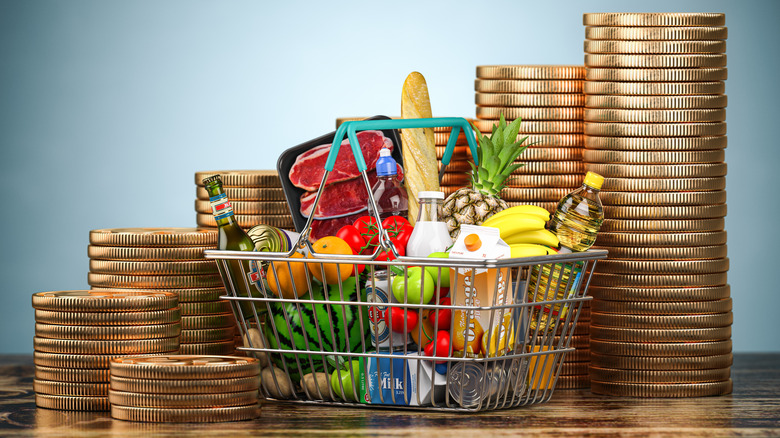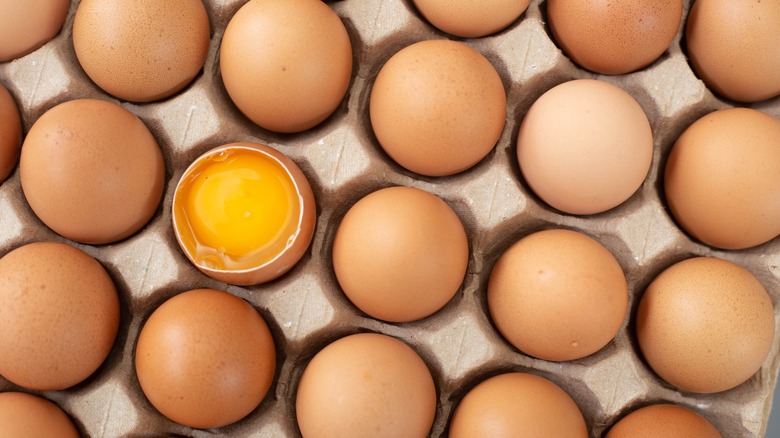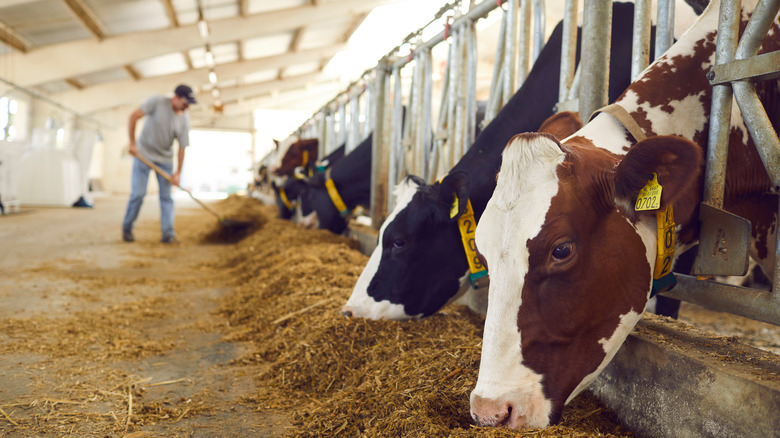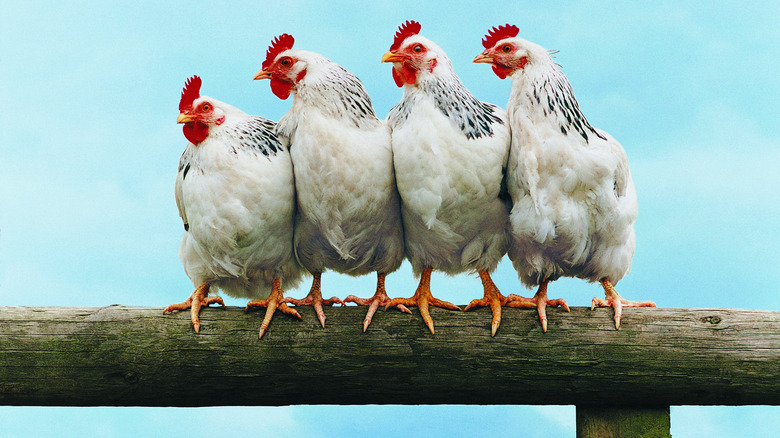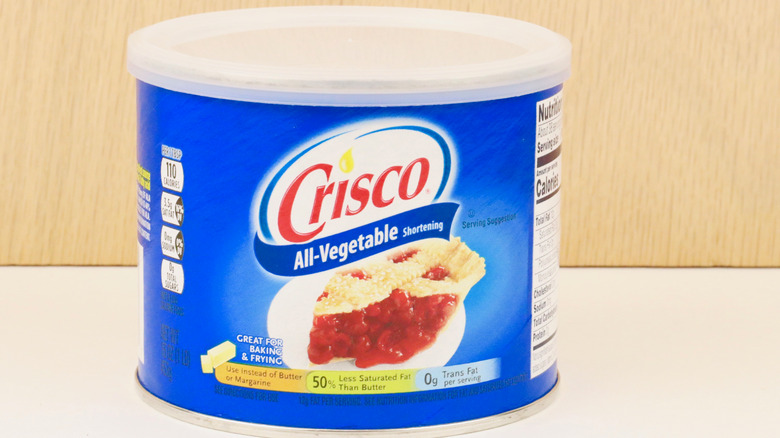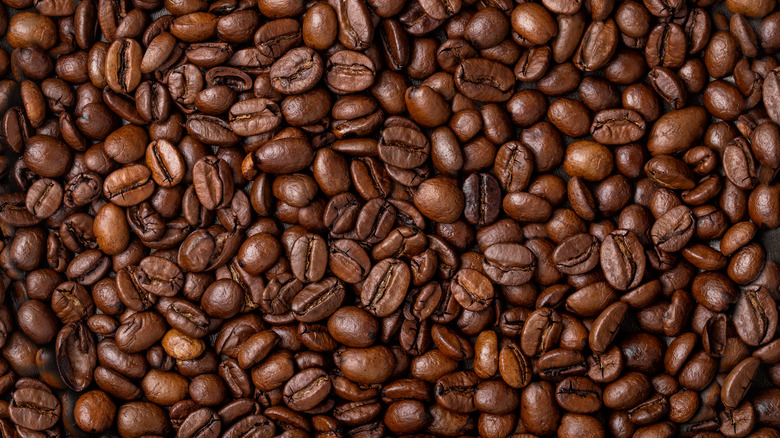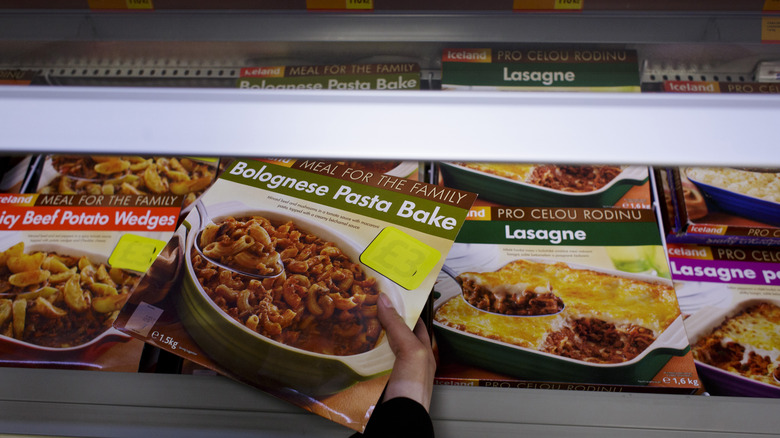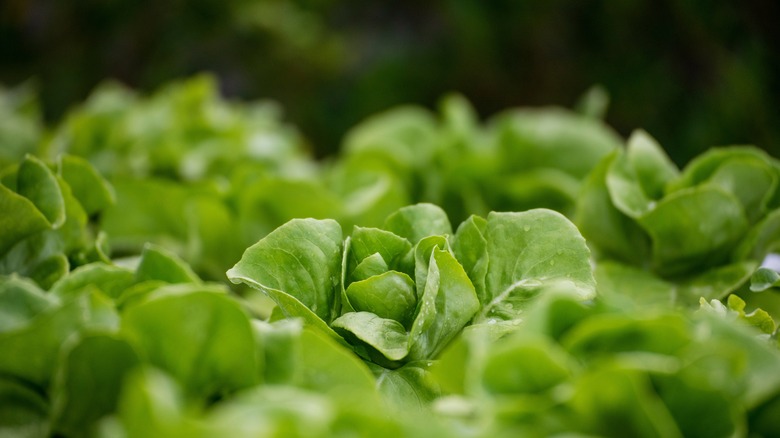The 10 Biggest Food Price Increases We've Seen So Far
It's no secret that money doesn't go as far in grocery stores as it once did. USA Today reported in 2022 that by August, groceries had seen a 13.5% price increase from the previous year, the largest price hike since 1979. Sadly, there's no single reason why prices are as high as they are. Increased prices can be traced to the continued pandemic-related disruption of the supply chain, growing energy costs, and issues relating to the Ukraine war and climate change. These are, however, only a few of the factors. Forbes also cites the growing cost of the major labor shortages and changes that are sweeping the country at the moment.
Still, there are a few silver linings to the current economic situation. Food costs are likely to remain historically high, but experts predict they won't rise as rapidly as in 2022. Produce Business has one major tip when navigating these unsure waters: Keep an eye on prices, and know what the current averages are for major goods. That way, you'll know when you've stumbled upon a good deal, or a price much too high given today's standards.
Eggs
Whether you're a proud omnivore or a meat-avoiding vegetarian, eggs are common staples to be added to breakfast, savory frittatas, or baked goods. But, this beloved food rose to pop culture fame in 2022 as the nation witnessed a historic and shocking hike in egg prices. As reported by CNBC at the end of 2022, the price of eggs increased by a jaw-dropping 49% during the year. So startling were the price increases that The New York Times reported on the egg memes that rose to fame along with eggs' rising prices to add a dose of humor to a generally humorless situation.
But there's a pretty big reason why egg prices have reached the heights that they have. The most deadly bouts of avian flu on record took place in 2022 when around 40 million hens died due to illness. Plus, it's not just that avian flu is lethal for 90-100% of chickens with the disease, but farmers typically need to kill off the entire flock to prevent further spread. These circumstances culminated in a pretty dire situation for the States' egg stock. Sadly, the lack of hens and eggs made for a perfect storm of price hikes, which worsened during the holiday season as consumers sought to make their favorite holiday goodies. While some experts are hopeful prices will stabilize in 2023, it seems they'll remain at an all-time high for at least the first quarter.
Beef
Unfortunately for meat lovers out there, beef is predicted to see price increases in 2023. Some, like those over at Stable Price, even believe high prices will continue through 2025. The source points a finger towards extreme drought that has led ranchers to reduce their herds substantially. Feedlot Magazine even points out that the current so-called "cattle inventory" is lower than in 2014 — the last recorded bottom of the cycle.
The beef magazine forecasts that the price of beef will largely depend on demand — if it increases, prices could potentially soar. And it's likely that different kinds of beef will be more sensitive than others. Finer, more luxury goods, like steak, are believed to be more affected, while ground beef may rise at a slower rate. With gloomy clouds on the horizon, now is a good time to explore different steak grades and perhaps explore the versatility of ground beef.
Margarine & butter
Whether butter or margarine is your spread of choice, both have seen unprecedented price hikes as reported by CBS News. As per the U.S. Bureau of Labor Statistics, margarine saw around a 44% increase in price, while the price of butter rose by around 31%. Surprisingly, there are separate reasons for these increases, and unfortunately, it could be a while before they lower in price.
Margarine, specifically, has been heavily hit by the war in Ukraine. The region is a large producer of vegetable oils that are used for making margarine. Unfortunately, with the war-caused deficit in vegetable oil production, compounded by an increase in energy and transport costs battering Europe, margarine prices have skyrocketed.
Butter, however, has mainly suffered due to the thinner dairy cow herds as a result of COVID-19-related financial circumstances. With fewer cows and less available milk, much of the milk intended for dairy by-products like butter was funneled into cheese production. There's some hope that as pandemic-related challenges become more manageable, butter prices could stabilize within the year.
Chicken
During the late spring of 2022, chicken — specifically chicken breast — hit record-high prices as reported by WATTPoultry.com. A CNN report explained that like many other foods, chicken prices rose due to a mix of issues in the supply chain, breeding, and increased demand. That said, it seems like chicken prices may offer some hope for consumers going forward.
As CNBC detailed at the time, by the fall of 2022, chicken prices declined significantly from the lofty heights they occupied in the spring. This was partially due to a lowered demand for poultry attributed to consumers refusing to pay such high prices for chicken. Plus, chickens bred for meat were spared the brunt of 2022's disastrous avian flu. As a result, supply increased, and prices quickly fell. Entering 2023, chicken prices remain low, though given the ups and downs they experienced in 2022, there's no telling if they'll be stable going forward.
Cooking oils
Cooking oils are a pretty big staple in the kitchen. Unfortunately, cooking oils have undergone heavy price increases, and everyone is starting to feel the weight of the added costs. One professional and artisanal doughnut maker interviewed by The Washington Post lamented the barrage of price increases during the pandemic, and how the staggering increase in vegetable oil cost has left small business owners with questions regarding how to make the same, high-quality products without passing all the costs on to the customer. It's hard to find a cheaper alternative as many oils are facing exceptionally high prices. Sunflower oil, for example, is largely sourced from Ukraine. Due to the war, as well as inter-European food politics and legislation, oil has seen a major, and indefinite, price hike.
Other oils, such as soybean and canola have been affected by droughts. Both of these oils, which are largely imports, have been impacted by in-land export restrictions which drive down supply and drive up prices. Despite palm oil's many controversies, of all the cooking oils, it is one of the oils that experts believe may come down in price in 2023, albeit gradually.
Crisco
Crisco is used as a shortening staple in many regions across the United States. But despite seeming like an all-American food, Crisco has been just as affected by world events, including the Ukraine war, droughts, and international shipping delays, as many other foods jumping in price. As reported by Food Dive, because Crisco is made from soybean and canola oils, it was inadvertently impacted by these worldwide issues and saw as much as a 23% price increase by the second quarter of 2022. While it's been noted that this major price hike may come down in the first quarter of 2023, it depends on whether cooking oils (and international tensions) reach some sort of stability. In the meantime, it could certainly be worthwhile to see just how far the can of Crisco can last. We'd suggest switching to butter or margarine, but given that those prices have increased even more, it may be time to cut back on baking for a while.
Coffee
It's no secret that coffee is a hot commodity, and even in the best economic circumstances, it can cost a pretty penny. As explained by New Ground Magazine, extreme weather and war are to blame for the most recent increased coffee costs.
Interestingly, the coffee magazine notes that you may see the effect of these price hikes in two separate ways. First, there may be a rise in the use of coffee roasts that have historically been considered cheap, such as robusta. New arabica-robusta blends may be put to use as a way to curb rising costs (possibly at the expense of quality). But increased costs for high-quality coffees won't only be seen in grocery stores. Cafés, big and small, will have to decide how much of the brunt of increased expenses they can shoulder themselves, and how much they need to pass on to the customer. Thankfully, there's some good news for those needing their caffeine fix: Joth Ricci, the CEO of Dutch Bros. Coffee told CNBC he predicts coffee prices will plateau midway through 2023, or as late as the end of 2024.
Grains and cereal
Grain and cereal prices suffered under a perfect storm in 2022. As Reuters reports, Ukraine is a major supplier of grain and the war sky-rocketed prices to never-before-seen highs. Meanwhile, poor environmental conditions like a drought in Argentina, and flooding in Australia, further sunk the world's grain supply and drove prices high.
Similarly, environmental conditions also affected domestic grain, as the U.S. experienced the lowest harvest of the decade. While the FX Empire remains somewhat optimistic that grain prices could drop in the first few months of 2023, they maintain that there's still a lot of volatility in the market.
Rice, on the other hand, is facing unusually high export fees from major suppliers like India. Predictions aren't good for 2023, at least for the first six months, so there's unlikely to be much change in cost.
Of course, suffering corn and wheat harvests have had a comparable effect on the prices of cereals (via International Monetary Fund). Additionally, cereal prices are connected to fertilizer prices, and given the spike of the latter in 2022, it remains unseen if cereal prices will continue to increase as a result. IMF concludes that while the price for cereal going forward is uncertain, prices may drop, but just barely.
Frozen, convenience, and ready-to-eat meals
There's a price to pay for comfort, and while some of us eagerly turn to ready-to-eat meals on the days when cooking just isn't the vibe, convenience comes at a cost. While these dishes are already known to be a bit pricier than from-scratch cooking, they've been hit by the overall rise in food prices as well. As described by Food Navigator at the end of 2022, frozen, ready-to-eat meals saw as much as a 15% increase year-over-year. It seems this has affected all sorts of frozen meals and other "center store" options which all experienced big jumps in prices.
But, sometimes price doesn't matter if it's comfort or convenience you're buying, and purchasing still remains high for ready-to-eat meals. This remains especially true when the selected ready-to-eat options are believed to be a better, more affordable, and health-conscious choice despite record price increases. In fact for some, frozen meals or meal delivery services like Blue Apron or HelloFresh! are seen as cheaper alternatives when they're viewed as a replacement for going out to eat. It really depends on perspective.
Lettuce
Let us discuss lettuce. According to WXXI News, lettuce was among the hardest-hit produce items in 2022 with lettuce staples like Californian romaine doubling, and sometimes tripling, in price.
Just as eggs were affected by the avian flu, lettuce in 2022 was killed off by an insect-generated virus carried by thrips. The disease (impatiens necrotic spot virus, or INSV) eradicated nearly 80% of the salad crop in the U.S.' biggest salad-growing region: the California Salinas Valley.
This was disastrous for many restaurateurs, specifically for more plant-based and vegan eateries that by nature go heavy on the veg. This isn't to say that home chefs aren't affected. Shoppers who are already shelling out more for basic goods may be paying double or triple what they've typically paid for leafy greens (via Yahoo!Life). While these price hikes won't last forever, you may want to look for leafy green alternatives for the time being.
